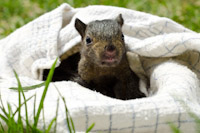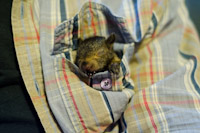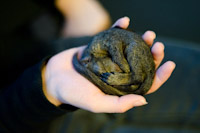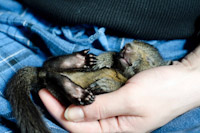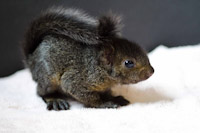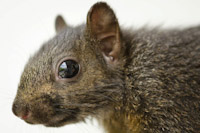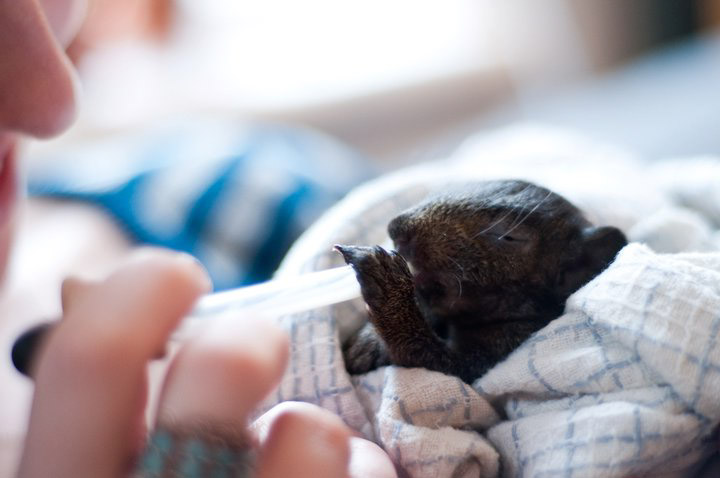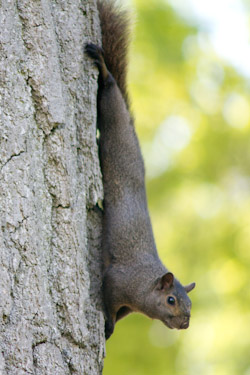Does the baby really need help?
First, determine if the squirrel really needs help.
If the baby squirrel’s eyes are open and it is able to move, climb trees and run away from you, it is probably ok.
Squirrel mothers will sometimes leave their babies unattended at this stage. As long as it is day time, then a squirrel in this condition should be left alone.
If the baby is in a dangerous spot, very near a busy road for example, it may be helpful to to frighten it away from the source of danger.
You may want to keep an eye on it and keep any pets indoors till it is re-united with its mother.
If you still think the baby needs help then read on.
Confine and warm the baby
If the baby appears very young, injured, listless or sick, or cold to the touch, confine it in a cardboard box with a warm water bottle on one end. (You can use a pop bottle filled with warm water wrapped with a towel.) The heat source should not cover the entire bottom of the box so the animal can move away from it if it gets too warm.
The next thing you should do is do a google search for “wildlife rehabilitation” for your area and try to reach a wildlife rehabilitation centre by telephone. Another alternative is to call a veterinarian in your area and ask them for the phone number of a wildlife rehabilitation centre.
No website can substitute for a live rehabilitation professional on the phone discussing the situation with you.
If you manage to reach a live person who can help you assess the situation, then stop reading my silly webpage page and follow their instructions.
If it is not possible to reach anyone because of the time of day, or because you haven’t managed to locate a wildlife rehabilitation centre yet then read on.
Think of the animal’s needs, not yours
Also at this point you may feel an irresistible desire to nurse this squirrel back to health yourself and to keep it as a pet. You may begin to hear that song “So Happy Together” in your head. Resist!
Make sure that you always keep the animal’s best interest at heart. Squirrels do not make good pets (they will gnaw on everything in your house) and are wild animals that want and deserve to live free.
Rehydrate
The next thing to do once the baby is secure and warm up is to look for signs of dehydration. Do not attempt to rehydrate a baby that is still cold. If the animal is not warm to the touch move it closer to its heat source, and do nothing else till it is warm (around 37°C or 98° F).
(During this whole time, someone should be working the phones trying to reach a wildlife rehabilitation centre, remember?)
To do this pinch the skin of the animal in the shoulder area to ‘tent’ it then release it. The skin should flatten out within a second or two. If it does not, or if the sides of the animal appear sunken and/or if the ribs are visible then it is dehydrated.
Dehydration can kill, so if the animal is dehydrated you should give the animal unflavored Pedialyte which you can obtain from a drugstore. Use a small syringe (without the needle!) which you can also obtain from a drugstore ad carefully feed the baby warm pedialyte by mouth.
It is important to go very slowly so that the baby does not aspirate the solution into its lungs! Slower is better. Remember that a small and weak animal will not be able to take in much pedialyte at a time.
Practice slowly squeezing the formula out of the syringe before trying to feed the baby. Also, some brand new syringes may stick, so it can be helpful to suck some water into the syringe first and work it back and forth af few times until the plunger moves smoothly.
You should continue to re-hydrate giving them 1cc of pedialyte, or as much as they will take of 1cc, every half hour.
No milk or formula!
After the baby is protected, warmed and rehydrated it gets more complicated.
A baby squirrel will need constant feedings (every two hours day and night) and will require hundreds of these feedings night and day for weeks to rehabilitate.
A baby squirrel can not eliminate on its own. That’s right you’ll have to help the baby to pee and poo till it can do so on its own.
We just thought we’d mention this in case you are still thinking you’d like to raise the squirrel and keep it as a pet.
Really, get help
The instructions on this page are only intended to help you protect and stabilize the baby squirrel. In case you haven’t figured it out by now, if you really want to give the baby squirrel the best chances of surviving, you really must try and contact a wildlife rehabilitation centre, get someone on the phone and follow their directions.
